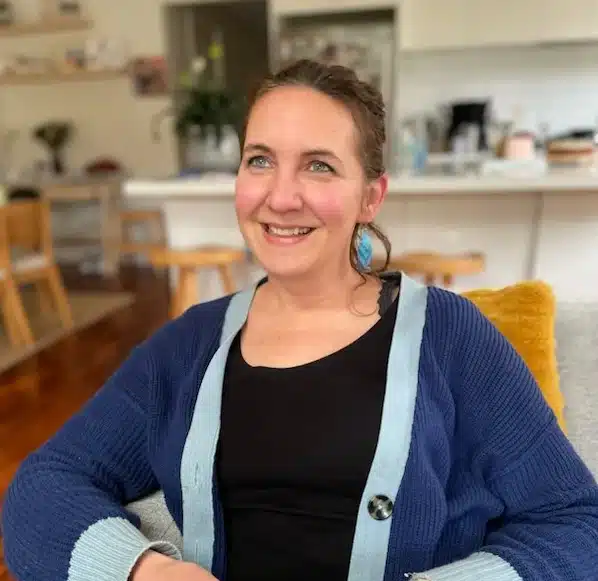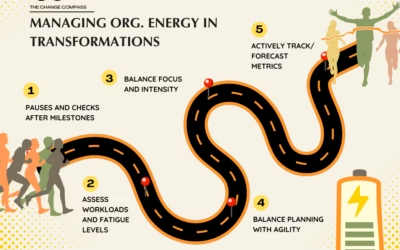In this Change Practitioner Q&A series, we talk to change managers to ask them how they approach their work. This time we are talking to Annah Kaspar.
Change Compass: Describe yourself in 3 sentences
Annah: I’m curious and a little irreverent because I want to know everything (except, controversially, about football). I love to hear people’s stories and tend to empathise deeply. Happiness is going to places I’ve never been, and hanging out with kind and interesting people.
Change Compass: What has been the most challenging situation for you as a change practitioner? Tell us what happened and how you fared through it.
Annah: It was not due to a type of change or a stakeholder group. It was working with a Program Manager who believed change management was an independent addendum of sorts, separate from the ‘main work’ of technology and process. They didn’t see how project stream interdependencies have a direct correlation to the quality of change outcomes, or that the best change outcomes occur when all project team members collaborate. This played out dreadfully when the PM refused to prioritise a gap analysis, despite this being a dependency for identifying changes and impacts.
The PM was unfamiliar with the flow-on effects. Unclear changes and impacts create ineffective change strategies, poor forecasting of time/effort/budget, ineffective stakeholder engagement and misaligned key messages. This creates low confidence in project solutions and poor adoption and change experience.
How did I fare? Suffice it to say it wasn’t fun for me or the stakeholders, and by that time the root cause (no gap analysis) was an abstract concept. I believe delivery alignment within a project team is one key indicator for delivery effectiveness across an organisation. When there are transparent and integrated project delivery plans and open dialogue about how all project team members play a valued role, then I know we can deliver superb change outcomes.
Change Compass: What are the most useful things to focus on when you first start on a project, and why.
Annah: I make a beeline for the project Business Case, or if there isn’t one, I work with others to get clear on the project drivers, especially the benefits. This is the ultimate ‘why’. If there are no connections between the project’s Business Case and the organisation’s strategy then I look to create these, otherwise the project is in trouble before it has even started.
All project outcomes, scope and solutions flow from the case for change. The next most important is a High Level stakeholder scan and a High Level impact scan. This requires data, data, data! The more the better, as it increases the odds of making better judgments. So even though it’s early days, it’s never too soon to capture data, and for that, you need the whole project team onboard with the critical role of collecting and validating it so you can optimise the delivery approach.
Change Compass: As change practitioners we don’t often get to stick around to see the fruits of our labour, but from your experience what are the top factors in driving full change adoption?
Annah: I was once on the receiving side of change, so I have strong views about this! If these four things are covered, then you’ve achieved sustainability:
- Active & visible leaders who advocate for the changes and put their reputation on the line to support success,
- A project team who co-creates integrated delivery strategies with impacted people
- Direct feedback loops for impacted people. These need in-built response mechanisms and complete psychological safety. No feedback should ever be punished or dismissed
- Post-project monitoring of key performance indicators (team and individual) with corresponding rewards to reinforce desired results and support where required to uplift results
Change Compass: You’re known to remain calm when there is a lot of stress and project drama around. What is your advice for others?
Annah: My tough but fair mentor once advised me to think up worst-case scenarios to prepare for challenges. It seemed counter-intuitive and overly negative at first, and would stress me out more! But over time, I saw that I too fall into the category of a perfectly nice and reasonable person who is overwhelmed by fear.
This mostly leads to unhelpful perspectives (cognitive distortions or ‘thinking traps’), unhelpful behaviours (character assassination, shutting down, unnecessary displays of overt authority etc) and ultimately a toxic workplace culture. So in difficult situations, the habit of thinking through not-so-great scenarios, combined with mindfulness, is just a basic form of risk management.
I’m now a huge advocate for speaking up early about risks and applying risk management to all aspects of project delivery. It’s not about ticking boxes. It’s about protecting us by counter-intuitively facing discomfort, creating emotional space for ourselves and others to regulate responses, and removing thinking traps so we can make those trade-off decisions to solve a project drama.
Change Compass: Thanks for sharing your experiences and wisdom with us Annah!






